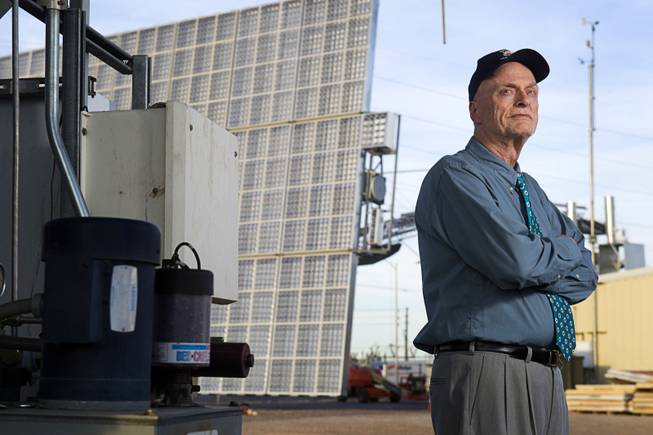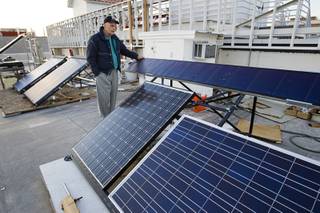
Robert Boehm, director for the Center for Energy Research at UNLV, stands by a concentrating photovoltaic power system at the UNLV Solar Site Wednesday, Feb. 22, 2012.
Sunday, Feb. 26, 2012 | 2 a.m.
Sun Archives
As the Obama administration was rolling out a budget that emphasizes renewable energy research and development, Robert Boehm, the director of UNLV’s Center for Energy Research, was in a motel outside Cleveland, preparing a last-ditch pitch to a NASA facility to support one of his research projects.
“We get no money from the state. We get no money from the university. We get a place to hang our hat and that’s it,” Boehm said. “If we don’t get a grant or a contract from some outside entity, we’re out of business.”
Nicknamed the “Saudi Arabia” of renewable energy by Sen. Harry Reid, Nevada has invested a great deal in marketing its sun-bleached deserts as the next frontier for renewable energy. That effort was greatly aided by federal spending — more than $3 billion in the state — which took a lot of the risk out of investing in the giant solar fields now under construction in Nevada.
But, as Boehm notes, the state hasn’t put nearly as much effort or capital into ensuring the state can become a leader in developing renewable technologies — better solar panels and windmills to tap the state’s geographic advantages.
As the Obama administration’s Energy Department budget watches some of its most aggressive loan and other incentive programs to build renewable projects wind down, leaders are trying to emphasize the importance of technology development. Nevada will have a lot of ground to make up in its efforts to invent, develop and manufacture the next generation renewable technology.
“Most of (the research projects) have gone to California, the Phoenix area and Albuquerque. If you go to those areas, you’ll find big solar companies there that are doing R&D, design, and fabrication,” Boehm said. “They’ve got a lot of miscellaneous technical services in those areas, while we have a lot of tourism and construction services. In Las Vegas, we’re just not geared up to that kind of thing. We really haven’t diversified our economy.”
•••
Economic diversification is the new mantra in Nevada. This month, Gov. Brian Sandoval unveiled an economic plan, with the help of the Brookings Institution, that identified renewable energy as one of seven key areas for development and investment, along with gaming technology, aerospace and defense, and mining.
The idea is that these industries would receive extra attention and funding to equip state universities and their private partners to commercialize new technologies, bringing jobs and higher tax revenue for Nevada.
“You have to start at the university level,” said former State Sen. Randolph Townsend, a Republican who spent years in the Legislature pushing for more renewable energy investment. “But in the case of most legislators, the long-term planning is fairly limited ... No wonder we’re falling behind. We’ve never adjusted our educational institutions to adapt to today’s demands.”
When UNLV’s Center for Energy Research, an 18-year-old facility, started taking a serious turn toward renewable energy research in 2000, the expectations were that the university would become a fulcrum for a new energy market in Southern Nevada. But, according to Boehm, other states have overtaken Nevada.
Townsend, now a member of the Nevada Gaming Commission, worked with Reid to secure funding for what is likely the state’s preeminent research collaborative for renewable energy, the Nevada Renewable Energy Consortium.
Desert Research Institute’s Clean Technologies and Renewable Energy Center, which is the part of the consortium, has been a sole or joint recipient of over $17 million in research funding for projects on biomass, solar, wind and geothermal, the bulk of which were funded by the Department of Energy.
Alan Gertler, director of the center, said the consortium was launched with funding from a Reid-sponsored earmark (back when earmarks were congressionally acceptable) that “is winding down” just as the labs should be intensifying their work.
The consortium has been trying to develop “the research infrastructure capacity here that can help bring new businesses into Nevada, to help not only develop these resources for export but also help develop new ways in which they can be used,” he said. But at this point “what we’re dealing with is real early-stage research.”
Nevada may have dreams of becoming a player in the renewable energy development market but it hasn’t convinced the federal government that it’s there yet. The federal government has designated it as an Experimental Program to Stimulate Competitive Research state, which means it receives special funds to build its research capacity because it is considered subpar.
As a preeminent facility for environmental research, DRI is able to attract scientists who bring well-funded research projects.
But other facilities aren’t as fortunate. At UNR, the head of its Renewable Energy Center left a year ago for a better offer in Utah, and the center is struggling to build a facility to house collaborative-discipline research like DRI is carrying out.
Until there’s money for the facility, “it’s really a virtual center,” said interim director Miles Greiner.
The type of research going on at UNR is also more theoretical than tangible — “focusing on producing papers that are presented in scholarly journals that can be the basis for the research on the products. That would be great for UNR to be developing products, but we haven’t been in the business of products,” Greiner said. “We’re doing the best that we can.”
•••
Nevada’s renewable energy boom of the past few years came as the federal government worked to raise the profile of renewable energy nationwide by giving investors incentives to get in on the ground floor of a growth industry.
The flagship federal program was the $20.5 billion renewable energy loan guarantee program: a pot from which companies working on Nevada projects secured almost $3 billion in fully or partially guaranteed loans.
That money — which made possible such projects as the Crescent Dunes SolarReserve energy storage project in Tonopah — dried up at the end of September. The administration and Congress, still reeling from the Solyndra scandal, have shown no interest in reviving it.
The federal government isn’t the only entity shifting gears: Nevada’s requirement that 15 percent of energy produced in the state come from renewable sources is almost met, leaving little local demand for power from renewable projects.
The other option is to sell to California. But the Silver State has yet to construct an entry point onto California’s electric grid.
This has renewable energy advocates calling for a sea change in Nevada’s approach to renewable energy.
“We can’t be simply an extraction-based economy,” said Walt Borland, executive director of the Nevada Institute for Renewable Energy Commercialization. “We’ve got to be more than that. But it will not happen overnight and it will not happen for free.”
The Nevada energy market Borland, Gertler and others envision won’t rely on outside investors but would generate, manufacture and produce the energy, the machinery and the technology at home. Ideally, the companies carrying this out would be incorporated in Nevada too.
It’s a deliberate effort to avoid what’s happened with Nevada’s other resource-driven industry: mining. Almost 90 percent of the companies operating in that “extraction-based economy” are headquartered out of state. Very little of the mining wealth generated in Nevada’s second-largest industry actually stays in Nevada.
Corporations expanding into Nevada presently are coming from as close by as California, and as far away as China: the ENN solar facility planned for Laughlin has been roundly lauded as a perfect mix of solar production and manufacturing for Southern Nevada.
To renewable energy development advocates, that’s all good — but still not the endgame.
“If we allow clean energy to be an extraction business, we don’t get anything downstream from it. If we aren’t getting anything downstream from re-engineering it, from redesigning it, then we again are losing an opportunity to create jobs and revenue,” Borland said. “We’re going to lose the opportunity to have a value-added economy.”
•••
The hang-up, most agree, is money: The state has been cutting its budget, including higher education. Funding for expensive research positions is a hard sell when 170,000 less-skilled state residents are desperate for jobs.
The Legislature last session set up the Knowledge Fund for research that could eventually lead to commercialization.
But it’s empty.
“Only in Nevada would you have the unfunded knowledge fund,” Borland said with a half-laugh followed by a sigh.
At the state level, many are looking to the private sector to make up the gap. The academic community, however, is not.
“You might hear that the private sector does invest in R&D, but it doesn’t,” Gertler said. “It comes from the government, and the private sector gets to take advantage of it.”
One of Boehm’s largest recent projects at UNLV was a partnership with, and funded by, Amonix. It’s the same Amonix facility that laid off two-thirds of its workers last month — and even before that happened, Boehm said, things weren’t going so great.
“They got a new CEO two years ago who said, 'OK, we’re going to do everything ourselves, we’re not going to farm out anything to UNLV or anywhere else unless they buy a big system from us,'” Boehm said.
Former U.S. Sen. Richard Bryan, a Democrat who lobbies for the renewable energy industry, said state labs ought to take better advantage of Reid’s influence as Senate majority leader in Washington to compete with bigger labs nationwide for research dollars.
“They’ve got to be creative, imaginative,” Bryan said. “Get off your derrière and think of something.”
Yet with budgets shrinking, it seems inevitable that the state will have to fill the fiscal bucket that for the past few years was primarily tended by Reid.
“The federal government is a wonderful place to get something started, but you have to understand the demands on the federal government in every state means whatever you do get is likely to be fairly limited in terms of its length,” Townsend said. “It’s one-shot money, which means you only get it once. It also means, when you start a process like this, you have to understand that you as a state are ready to pick that ongoing expense up, no matter what it is. And then you’re going to have to build it, no matter what it is.”
State officials say the thinking has changed. They expect the Legislature to keep building the state’s renewable energy capacity in the next legislative session.
“It took us a while to realize that, but over the past year or so I think we’ve pretty much universally accepted that the economy’s going to be different in the future,” said Steve Hill, director of the Nevada Office of Economic Development. “The commercialization of research and development that actually produces jobs and businesses in Nevada is something that we will have to be more focused on. And I think there will be more of a financial commitment.”


Join the Discussion:
Check this out for a full explanation of our conversion to the LiveFyre commenting system and instructions on how to sign up for an account.
Full comments policy